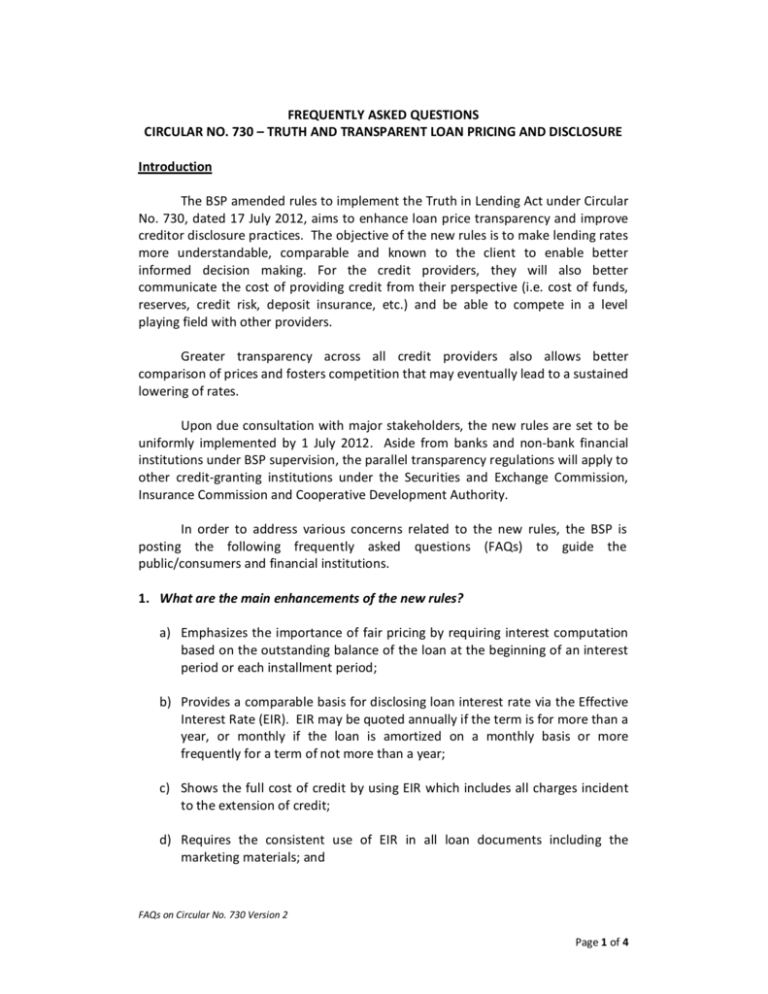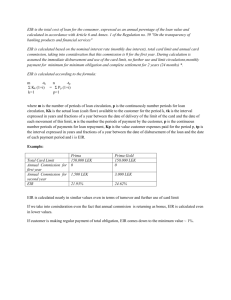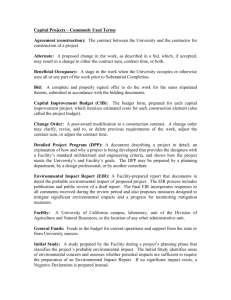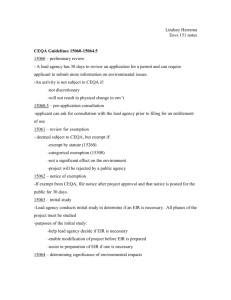TAB40-Monetary Authorities Survey_new definition
advertisement

FREQUENTLY ASKED QUESTIONS CIRCULAR NO. 730 – TRUTH AND TRANSPARENT LOAN PRICING AND DISCLOSURE Introduction The BSP amended rules to implement the Truth in Lending Act under Circular No. 730, dated 17 July 2012, aims to enhance loan price transparency and improve creditor disclosure practices. The objective of the new rules is to make lending rates more understandable, comparable and known to the client to enable better informed decision making. For the credit providers, they will also better communicate the cost of providing credit from their perspective (i.e. cost of funds, reserves, credit risk, deposit insurance, etc.) and be able to compete in a level playing field with other providers. Greater transparency across all credit providers also allows better comparison of prices and fosters competition that may eventually lead to a sustained lowering of rates. Upon due consultation with major stakeholders, the new rules are set to be uniformly implemented by 1 July 2012. Aside from banks and non-bank financial institutions under BSP supervision, the parallel transparency regulations will apply to other credit-granting institutions under the Securities and Exchange Commission, Insurance Commission and Cooperative Development Authority. In order to address various concerns related to the new rules, the BSP is posting the following frequently asked questions (FAQs) to guide the public/consumers and financial institutions. 1. What are the main enhancements of the new rules? a) Emphasizes the importance of fair pricing by requiring interest computation based on the outstanding balance of the loan at the beginning of an interest period or each installment period; b) Provides a comparable basis for disclosing loan interest rate via the Effective Interest Rate (EIR). EIR may be quoted annually if the term is for more than a year, or monthly if the loan is amortized on a monthly basis or more frequently for a term of not more than a year; c) Shows the full cost of credit by using EIR which includes all charges incident to the extension of credit; d) Requires the consistent use of EIR in all loan documents including the marketing materials; and FAQs on Circular No. 730 Version 2 Page 1 of 4 e) Provides a simpler disclosure statement which includes the key information useful for the borrowers. 2. What are the minimum required information to be disclosed to the borrower? Based on research and focus group discussions, the following are the required information to be included in the disclosure form that are most relevant and useful to the borrower for purposes of informed decision making: a) Loan amount; b) Upfront charges/deductions collected; c) Net proceeds of the loan; d) Schedule of payments; e) EIR; and f) Conditional charges, if any. The credit provider may also expand the document to improve client’s information. 3. Are the revised rules applicable to all types of loans? Yes. The rules and sample format of Loan Disclosure Statement are applicable for all types of loans. However the implementation will focus on retail loans, small business, agricultural and consumer loans. 4. What is the importance of the EIR? EIR is the rate that exactly discounts estimated future cash flows through the life of the loan to the net amount of loan proceeds. It is the rate that best measures the true cost of credit. The derived EIR formula includes all charges incident to the extension of credit. 5. What is the formula used for the EIR calculation models? The BSP adopts the universally accepted EIR formula of: Annual Effective Interest Rate (EIR) Where: i n = (1 + i)ⁿ - 1 = = periodic interest rate number of periods in a year FAQs on Circular No. 730 Version 2 Page 2 of 4 The term “periodic” in “periodic interest rate” refers to the time between installments (daily, weekly, semi-monthly, monthly, etc.), while the “number of periods in a year” will depend on the mode of payment or payment term of the loan (daily, weekly, semi-monthly, monthly, etc.). Upfront charges and grace period have a material impact in the computation of the EIR. As such, Internal Rate of Return (IRR) of future estimated cash flows over the term of the loan should be determined to get the periodic interest rate. The nominal rate, which is the contractual rate, shall be the main basis for the EIR calculation. However, the EIR will appear higher than the nominal rate because it will include interest, fees and charges incident to the extension of credit. It provides the borrower a complete and comparable total cost of credit. 6. What are the charges included in the EIR computation? a) Interest; b) Service charge/processing fees; and c) Other charges/fees incidental to the extension of credit (e.g. documentary stamps, notarial fees, appraiser’s fee, etc.) Imposable charges/fees should be identified and clearly explained by the entities to their clients. Fees incidental to the extension of credit are those that are collected exclusively because of the loan. As a general rule, taxes should be borne by the credit providing entity and should not be passed on to consumers. In case any of these are paid by the borrower, these should be indicated in the Disclosure Statement and included in the computation of EIR. Further, owing to the independent benefits an insurance coverage brings to the client and his/her heirs, even if offered side by side with a loan, premiums should not be considered in the EIR computation. The terms and conditions of the insurance coverage should, however, be clearly explained to the borrower. More so, savings is a separate product/service with its own benefit and value to the clients that is independent of the loan. Compulsory savings component forms part of client’s savings account which can be withdrawn upon demand or once the loan is paid in full, therefore, this is not a charge and should be excluded from the computation of EIR. Finally, conditional charges also do not form part of EIR computation as these depend only on contingent events and are not expected in the ordinary course of the loan. FAQs on Circular No. 730 Version 2 Page 3 of 4 7. Are entities allowed to charge add-on interest to the principal? Can this be amortized on a straight-line method? No. Add-on interest and straight-line methods are prohibited. Interest and service charge directly attributable to the granting of credit shall be amortized using the effective interest method. 8. Is the entity allowed to deduct advanced interest on the date of the loan grant? Yes, advanced interest may be collected. 9. Are there templates that financial institutions can use that will automatically reflect the schedule of amortization? The EIR calculation models as illustrated in Memo No. M-2011-040, are mere guides for financial institutions to demonstrate the underlying principles of discounted cash flow analysis which is the basis of EIR calculation. The entity would have a unique calculation depending on its specific loan terms. It is encouraged to develop a program to automatically calculate EIR for a given loan. 10. What are the sanctions in case of non-compliance with the required disclosure statement? Non-compliance by BSP regulated entities of the required disclosures shall be covered by sanctions provided under Section 6 of R.A. No. 3765 (Truth in Lending Act). Additionally, non-compliance with the MORB provisions shall be covered by Sections 36 and 37 of R.A. No. 7653 (New Central Bank Act). Similar sanctions are likewise provided by other regulators on their regulated entities. 11. In case of violations by credit-granting institutions, can you enumerate the appropriate venue for consumer complaints? For institutions supervised by the BSP, consumers are urged to file a formal complaint to the institution with which they are transacting. Should their complaint be unresolved, consumers may forward their complaint to the BSP Financial Consumer Affairs Group (FCAG). Complaints regarding other credit granting institutions, consumers may forward their complaint to the respective regulatory agencies. (i.e. SEC, IC and CDA). Coordination regarding the enforcement of the rules is also being undertaken with the Department of Trade and Industry and the Department of Interior and Local Government. FAQs on Circular No. 730 Version 2 Page 4 of 4






